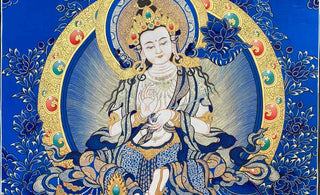
Introduction:
Thangka art, a traditional form of Tibetan Buddhist painting, has a rich and profound history deeply intertwined with the cultural and spiritual tapestry of Tibet. In this exploration, we delve into the origins of Thangka art, unraveling its historical roots and understanding its evolution within the context of Tibetan culture.
I. Early Influences:
Thangka art finds its roots in the early influences of Tibetan Buddhism, a spiritual tradition that migrated from India to the high plateaus of Tibet. The integration of Buddhist teachings with the indigenous Bon religion laid the foundation for the unique artistic expression that would later become Thangka art. Early practitioners sought to encapsulate the profound concepts of Buddhism in visual form, giving rise to the distinctive style that defines Thangka paintings.
II. Religious Significance:
In the realm of Tibetan Thangka art, the profound spiritual significance extends beyond mere aesthetics, exemplified by the reverence bestowed upon these intricate paintings. Among the myriad depictions within this sacred tradition, the portrayal of deities, mandalas, and scenes from the life of Buddha stands as a testament to the art form's role as a conduit for spiritual practice.
Thangkas, such as the "Zhajilamu (Shakyamuni Buddha) Tibetan Thangka Pendant Full-length Image," encapsulate the essence of Tibetan Buddhism in a visually arresting manner. This specific Thangka, with its full-length portrayal of Zhajilamu, also known as Shakyamuni Buddha, serves as a tangible embodiment of enlightenment. The pendant, intricately adorned with symbolic details, becomes a portable shrine, facilitating a connection with the divine in everyday life. Every element, from the nuanced facial expressions of the Buddha to the precise rendering of mudras (hand gestures), is purposeful and laden with meaning, inviting the practitioner into a contemplative journey. The depiction of Zhajilamu in this Thangka pendant is not a static representation but a dynamic tool for meditation, a focal point for the mind to delve into the depths of Buddhist teachings. The inclusion of mandalas further amplifies the spiritual significance, as these geometric configurations symbolize the cosmic order and serve as portals to higher consciousness. The wearer of such a Thangka pendant carries with them a portable sanctuary, a sacred object that transcends the boundaries between the mundane and the divine. As the intricate details unfold, each brushstroke becomes a step on the path to enlightenment, and each color carries a resonance with the vibrancy of spiritual awakening. The choice of materials, whether traditional pigments or contemporary ones, becomes a conscious decision, contributing to the evolving narrative of Thangka art.
In a world where spirituality and art intertwine, Thangka pendants like the "Zhajilamu Tibetan Thangka Pendant Full-length Image" serve as both a reflection of the rich cultural heritage and a beacon guiding the seeker towards a deeper understanding of existence. Beyond the physical adornment, these pendants become tools for transmitting esoteric knowledge, embodying the wisdom passed down through generations. The wearer becomes a custodian of tradition, a link in the unbroken chain connecting the past, present, and future. As Thangka art continues to evolve, embracing modern influences while staying rooted in its spiritual essence, each pendant becomes a living testament to the resilience of Tibetan culture. In a world that often moves at a relentless pace, these Thangka pendants offer a moment of stillness, an opportunity for introspection, and a visual narrative that transcends the boundaries of time and space. Thus, the "Zhajilamu Tibetan Thangka Pendant Full-length Image" is not just a piece of jewelry; it is a sacred artifact, a miniature masterpiece that encapsulates the soul of Tibetan Thangka art, inviting individuals into a journey of self-discovery and spiritual awakening.
III. Evolution Through Time:
As Tibetan culture evolved over the centuries, so did Thangka art. The art form absorbed influences from neighboring regions, adapting and incorporating diverse elements while maintaining its distinct identity. The migration of Tibetan artists to regions like Nepal and Bhutan further enriched the artistic heritage of Thangka.
A. Regional Variations:
Different regions developed their own styles and variations of Thangka art, influenced by local aesthetics and cultural nuances. The Nepalese Thangka tradition, for example, exhibits a synthesis of Tibetan and Newar styles, creating a unique fusion of artistic expressions.
B. Patronage and Artistic Lineages:
The patronage of Thangka art by Tibetan monasteries, aristocracy, and later, Western collectors, played a crucial role in sustaining and evolving the tradition. Artistic lineages were established, with master painters passing down their skills and techniques to apprentices, ensuring the continuity of this sacred art form.
IV. Cultural Context:
To truly understand Thangka art, one must appreciate its deep connection to the cultural and religious fabric of Tibet. The paintings are not isolated artifacts but integral components of religious ceremonies, festivals, and rituals, contributing to the immersive experience of Tibetan Buddhist practice.
A. Ritualistic Use:
Thangkas are often displayed during religious ceremonies and festivals, becoming focal points for collective worship. The vibrant colors and symbolic imagery serve to evoke a sense of spiritual presence, creating a sacred atmosphere within monastic spaces.
B. Preservation Challenges:
In the face of modernization and geopolitical challenges, the preservation of Thangka art faces significant hurdles. The migration of Tibetan communities, political unrest, and commercialization pose threats to the traditional practices and authenticity of this ancient art form.
Conclusion:
Thangka art stands as a testament to the rich cultural and spiritual heritage of Tibet. Its origins, deeply rooted in the intersection of Buddhism and indigenous beliefs, have given rise to a unique form of visual expression. As we trace the evolution of Thangka art through time, from its early influences to its diverse regional variations, we gain insight into a tradition that transcends the boundaries of art and spirituality. In the face of contemporary challenges, the preservation of Thangka art becomes not only a cultural imperative but a commitment to safeguarding the spiritual legacy it encapsulates.

Zhajilamu (Shakyamuni Buddha) Tibetan Thangka Pendant Full-length Image























